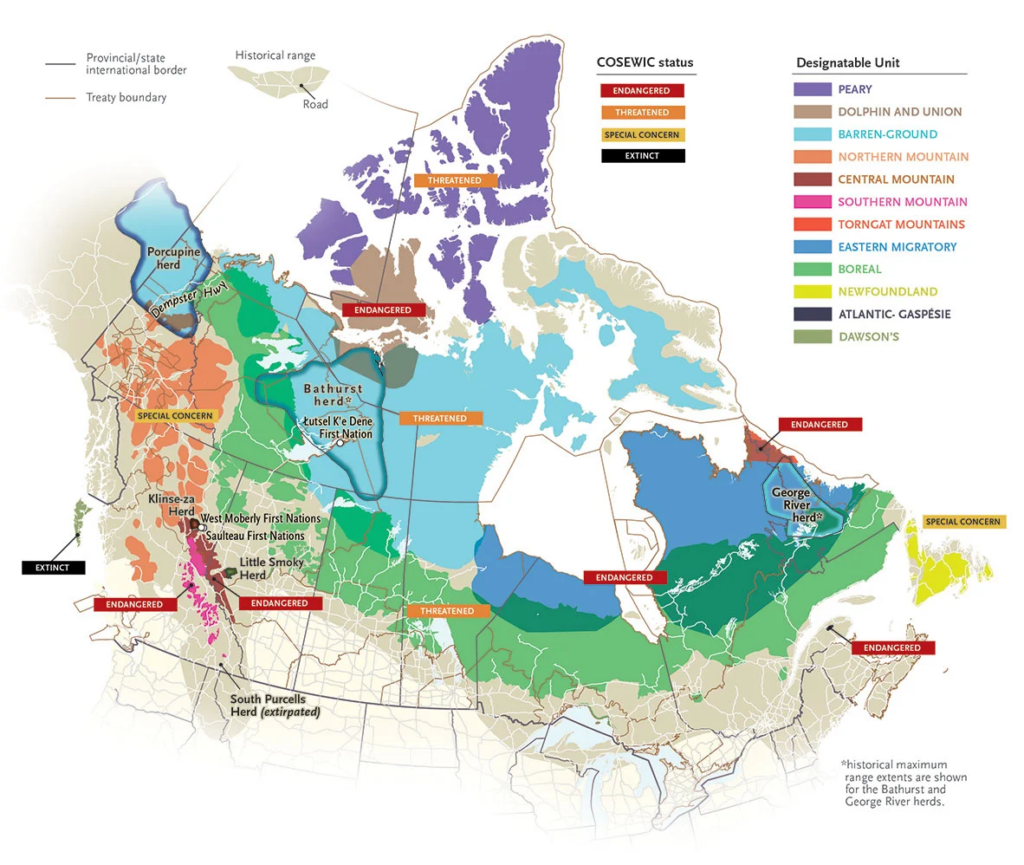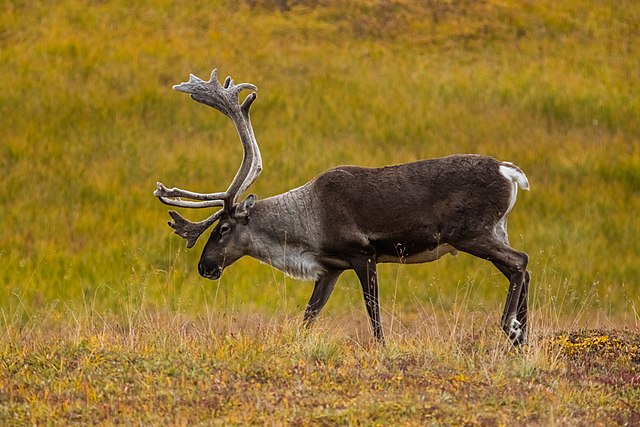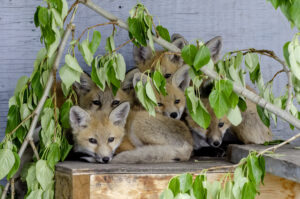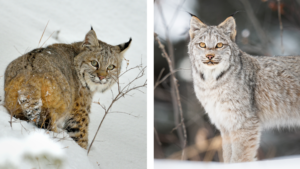By Kendra Thomas
Caribou are members of the ungulate family, a family that includes hoofed mammals such as deer and moose. Caribou can be found in many regions across Canada and have adaptations that allow them to thrive cold, snowy environments.1 Some of these adaptations you can see, such as their thick fur coats1 and snowshoe-like hooves.2 Other physiological adaptations can’t be seen, such as the caribou’s ability to maximize the nutrients available in their food sources, allowing them to spend their winters subsisting on nutrient-poor foods such lichen.2
Although these adaptations have allowed caribou to survive on earth for over a million years, caribou across the globe face threat of extinction.2 Caribou populations are designated as threatened under Alberta’s Wildlife Act, , and recent studies indicate that caribou populations in Alberta are declining by approximately 50% every eight years.3 In the past decades significant conservation efforts, scientific analysis, and federal and provincial legislation have all sought to protect caribou, but these efforts have largely failed to slow population decline.2
Why are Canadian caribou populations declining?
There are a number of factors that appear to be contributing to declining caribou populations.1 Many caribou species, including the Southern Mountain Caribou in B.C. and Alberta, require mature forests to survive.1 Caribou have many predators, which include wolves, coyotes, cougars and black bears.1 Mature forests attract fewer predators than younger forests as there are fewer ungulates, a predator attractant.1 Furthermore, the features of a mature forest prevent predators from moving quickly through the area.1 This makes mature forests an advantageous habitat for caribou.1 Human activities, ranging from industrial exploration and development to recreation, reduce the availability of mature forest and caused fragmentation of remaining forest, increasing the density of predators in these areas.2
Other species of caribou, including the Peary Caribou and the Barren-ground Caribou, are found in Arctic and sub-Arctic environments.1 These species are greatly impacted by a number of factors associated with climate change.1 Changing weather patterns influence the availability of food, as well as the rates of parasites and diseases.1 Climate change also reduces the sea-ice habitat that some caribou herds use during their migrations to calving grounds.1
All species of caribou present in Canada appear to be impacted by the increasing frequency and severity of wildfires.1 Caribou typically avoid wildfire-affected areas for several decades due to reduced food availability and improved access for predators.1 When considering the compounding impacts of habitat loss from wildfires paired with habitat loss from human activity, the availability of alternative habitats is quickly decreasing. This decrease in habitat availability is met with increasing predator populations due to improved access to prey in disturbed areas.2

How can I help?
Loosing caribou is about more than losing a species.1 Caribou are known as a keystone species, meaning that their presence provides food for other organisms and cycles nutrients within the ecosystem.1 Therefore, the potential loss of this species is expected to have cascading impacts across Arctic and Boreal ecosystems.2 Furthermore, caribou are extremely important to Indigenous Peoples, to whom caribou are an important part of their culture and identity.2, 4
Hope is not lost for the recovery of Canada’s caribou population and conservation efforts are currently underway. Strategies include protecting habitat within designated caribou ranges, the creation of caribou knowledge sharing networks, and conducting research to understand how climate change is expected to impact caribou habitat and how that habitat can be restored.1 Perhaps the most successful recovery effort has been Indigenous-led conservation, which led to a herd in B.C. nearly tripling in size during an eight-year period from 2013 to 2021.4
All Canadians can help support caribou populations. You can:
- reduce the impact of your outdoor activities by sticking to designated trails when outdoors;1
- reduce your carbon footprint to slow climate change;1
- support Indigenous-led conservation efforts;4 and
- support healthy ecosystems by reaching out to AIWC if you locate injured or orphaned wildlife that you think may require rescue and rehabilitation.
Footnotes
- Government of Canada. “Caribou in Canada.” February 1, 2022. https://www.canada.ca/en/environment-climate-change/services/species-risk-education-centre/caribou.html
- Mitchell, Alanna. “Caribou Are Vanishing at an Alarming Rate. Is It Too Late to Save Them?” Canadian Geographic, July 25, 2023. https://canadiangeographic.ca/articles/caribou-are-vanishing-at-an-alarming-rate-is-it-too-late-to-save-them/.
- Alberta Wilderness Association. “Caribou”. June 7, 2023. https://albertawilderness.ca/issues/wildlife/caribou/#:~:text=Based%20on%20limited%20observations%20from,Caribou%20Range%20Plan%2C%202017).
- Lamb, Clayton T., Roland Willson, Carmen Richter, Naomi Owens‐Beek, Julian Napoleon, Bruce Muir, R. Scott McNay, et al. “Indigenous‐led Conservation: Pathways to Recovery for the Nearly Extripated Klinse-Za Mountain Caribou.” Ecological Applications 32, no. 5 (2022). https://doi.org/10.1002/eap.2581.
Title image: http://Caribú (Rangifer tarandus), Parque nacional y reserva Denali, Alaska, Estados Unidos, 2017-08-30, DD 40.jpg






